ICT Initiatives
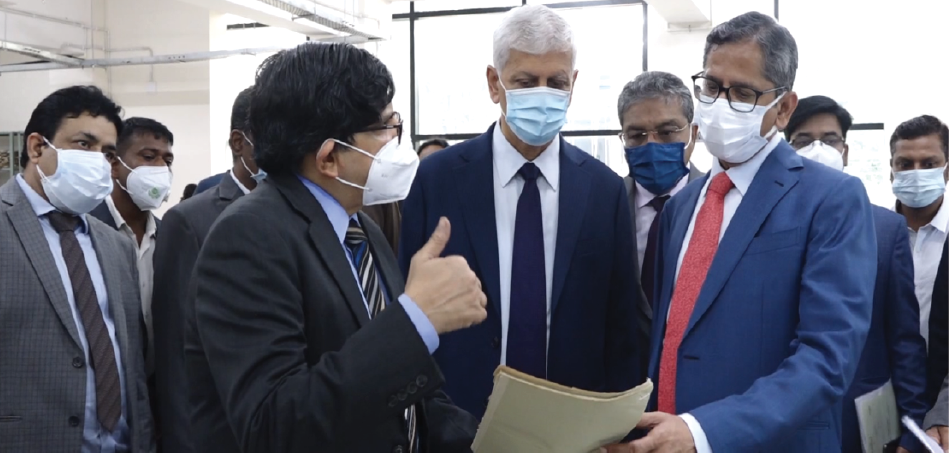
Mr. Justice Vineet Saran, Judges of the Supreme Court of India to the RRDC on 25th September, 2021
In January 2021, the High Court was already facing the challenge of consignment, storage, preservation and disposal of thousands of legacy records i.e., the record of cases disposed of. Although the Benches were functioning in two separate buildings (Heritage & New), the Administrative and Judicial Sections in the Heritage Building were operating in clogged spaces due to the ever-increasing number of files and records. Even the corridors were crammed with cupboards and shelves containing files and records.
Concerted steps were undertaken with the support of the IT & AI Committee for reworking the process of dealing with disposed of case records including laying down a comprehensive procedure for storage, scanning, preservation and destruction of such records.
Meanwhile, owing to the abolition of Odisha Administrative Tribunal (OAT), a newly constructed building meant for the OAT at Cuttack adjoining the Odisha Judicial Academy became available for use. It was found suitable to accommodate the Record Rooms of the High Court as well as its Scanning and Digitization sections.
The OAT building was suitably modified in record time and the Criminal and the Civil Record Rooms as well as the Scanning and Digitization Centre of the High Court were shifted there.
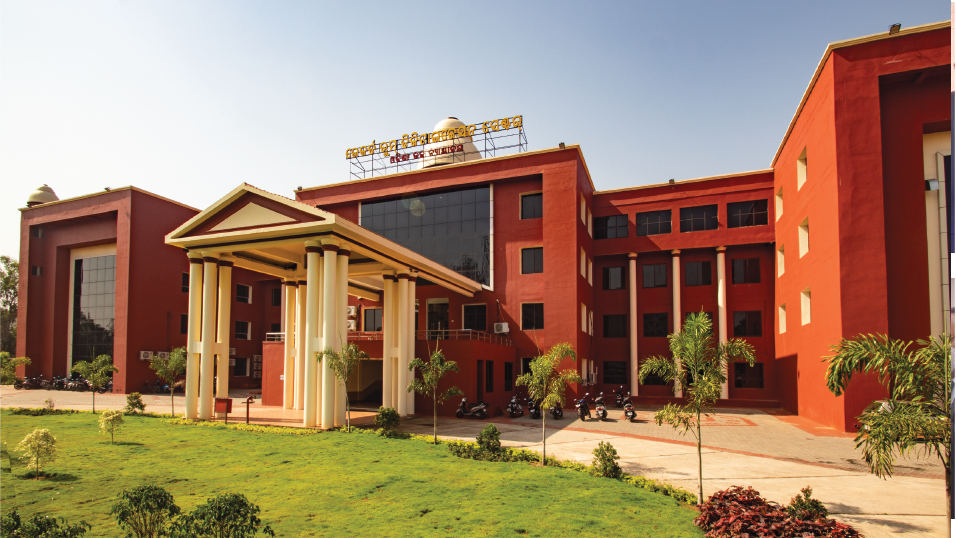
The Record Room Digitization Centre (RRDC) was inaugurated by Dr. Justice D.Y. Chandrachud, Judge, Supreme Court of India and the Chairperson of the Supreme Court’s e-Committee on 11th September 2021.
It is equipped with the latest firefighting system and security measures. There are sufficient numbers of elevators in the building.
The RRDC has three layers of functional space i.e., in its ground, first and second floors. The ground floor houses the Civil Record Room along with its office, the Fragile Record Room containing legacy records dating back to the early 1800s when parts of the Odisha province fell within the jurisdiction of the Patna High Court, the Calcutta High Court and the Madras High Court. These records in their original form have been kept under special care for long-term preservation. Due to their fragility, they are not in a position to be immediately scanned. The fragile legacy records of District Court, Cuttack are also stored in an earmarked room in the ground floor. The Shredding Room where physical legacy records are destroyed in high-performance shredding machines after their scanning and digitization is also located in the ground floor.
The first floor is where the High Court’s Civil Records scanning along with ancillary digitization processes for all types of legacy records are carried out. Among the four pilot District Court Digitization Centres i.e., Cuttack, Ganjam, Balasore and Sambalpur, the District Court Digitization Centre of Cuttack functions in the first floor of RRDC. Space has also been provided on the first floor for storage of District Court, Cuttack’s legacy records.
The High Court’s Criminal Record Room and the Scanning Centre for legacy criminal records are located in the second floor of the RRDC. Sitting and recreational space is available for the personnel working on each floor of the building.
The core objective of RRDC, besides freeing of space in the Heritage Building of High Court, is to bring the High Court’s Record Rooms and the Scanning Centre under one roof to reduce the scope of record movement and accordingly minimize the chances of their being misplaced, damaged or lost. In order to augment the utility of the RRDC, the Rules relating to preservation, scanning and destruction of disposed of records of the High Court have also been amended so as to:
a. reduce the retention period of certain categories of records (thereby minimizing the strain on the Record Rooms);
b. providing for scanning of complete records (thereby reducing dedication of time and human resource required for segregating disposed of records into different parts);
c. lay down protocols for metadata entry providing comprehensive information about the scanned records at a glance;
d. mandate verification of scanned records and their metadata entry before their destruction;
e. ensure integrity and security of data relating to scanned records by removing the electronic repository of such data from the scope of any external access other than through Court’s secured network;
f. ensure permanent preservation of fragile records (which cannot be scanned due to their fragility) in their original form in earmarked Fragile Record Room;
g. provide for metadata entry and non-destruction of documents whose originals are required to be retained in view of the first schedule of the Information Technology Act, 2000 such as deed of will, sale deed, power of attorney etc.;
h. lay down detailed Standard Operating Procedure (SOP) for scanning and digitization of legacy records;
i. prescribe duties of the agency carrying out the scanning and digitization work;
j. prescribe the mode and manner of scanning LCRs and promptly returning those to the concerned Court.
Please see Appendix E for details of the Rules.
In order to take the concept and practice of storage, scanning, preservation and retrieval of legacy records to the District and Taluka Courts, District Court Digitization Centres (DCDCs) in four major District Courts of Cuttack, Ganjam, Sambalpur and Balasore have been established on pilot basis. These four DCDCs were inaugurated on 30th April, 2021.
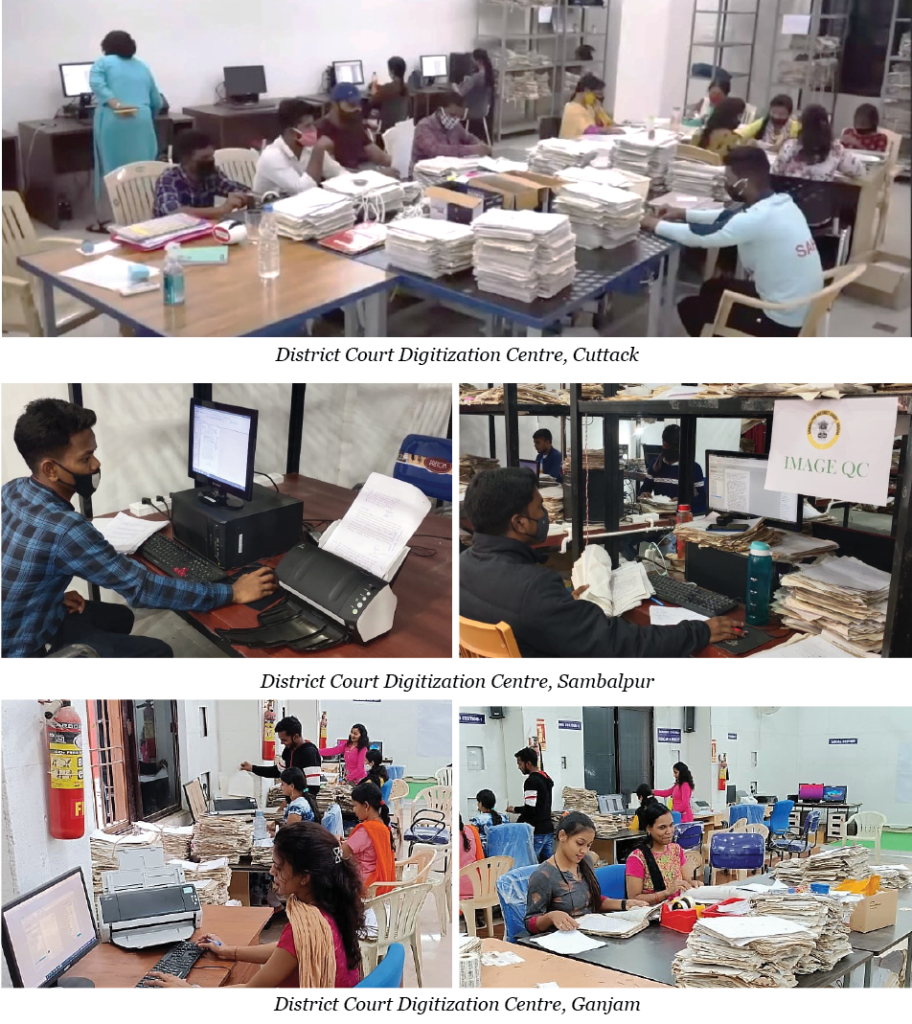
The technological backbone for this initiative has been provided by Odisha Computer Application Centre (OCAC) which is a nodal IT agency of the Government of Odisha. The work of scanning and digitization in each of the DCDCs is carried out by a separate dedicated agency empanelled and nominated for the purpose by OCAC.
In order to maintain uniformity in the process of scanning and digitization carried out in the RRDCs as well as in the DCDCs, a common SOP has been formulated and circulated among the four DCDCs.
Further, to regularly monitor the work of scanning and digitization in the DCDCs, a Judicial Officer has been nominated as the Nodal Officer in each DCDC.
The statistics of scanning and digitization at the DCDCs as on 31st December 2021 stood as follows
| Name of the District Court Digitization Centre | Name of the Agency in charge of the Scanning work | Number of records scanned | Number of case records uploaded in the DMS server |
| Cuttack | Computer Lab Pvt. Ltd, Cuttack | 38,360 | 24,689 |
| Balasore | Sarada Systems | 26,162 | 7,429 |
| Ganjam | Anthem Global Technology Services, Bhubaneswar | 33,203 | 20,581 |
| Sambalpur | Suyog Computech | 28,586 | 11,194 |
| Total | 1,26,311 | 63,893 |
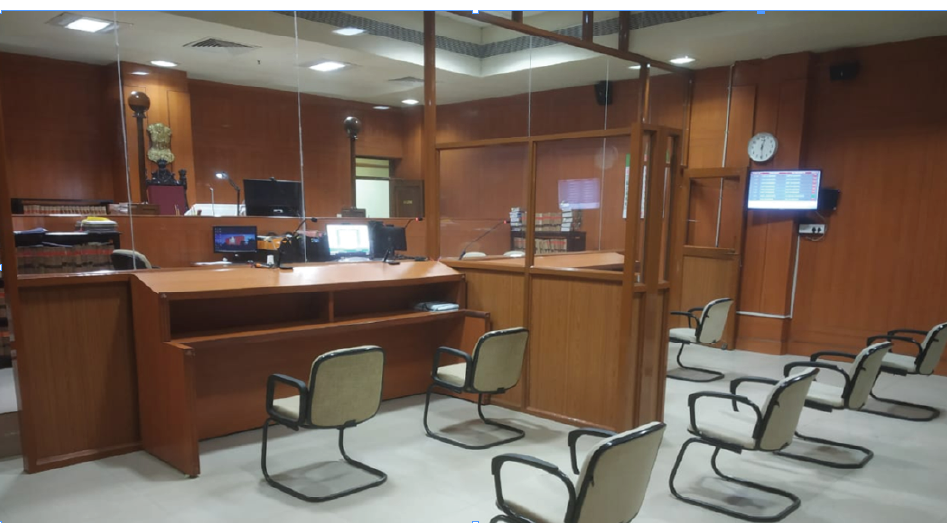
In 2020, the High Court of Orissa and the District Courts had already taken steps during the first wave of the COVID-19 pandemic to use ICT to conduct Court proceedings.
With the pandemic continuing during 2021, the ‘hybrid hearing system’ was introduced in the High Court on 15th February 2021.
Using the latest audio & video management equipments in every functional Courtroom, lawyers physically present and those connected through video conferencing were able to address the Bench seamlessly. A Standard Operating Procedure for Hybrid Hearing is at Appendix F.
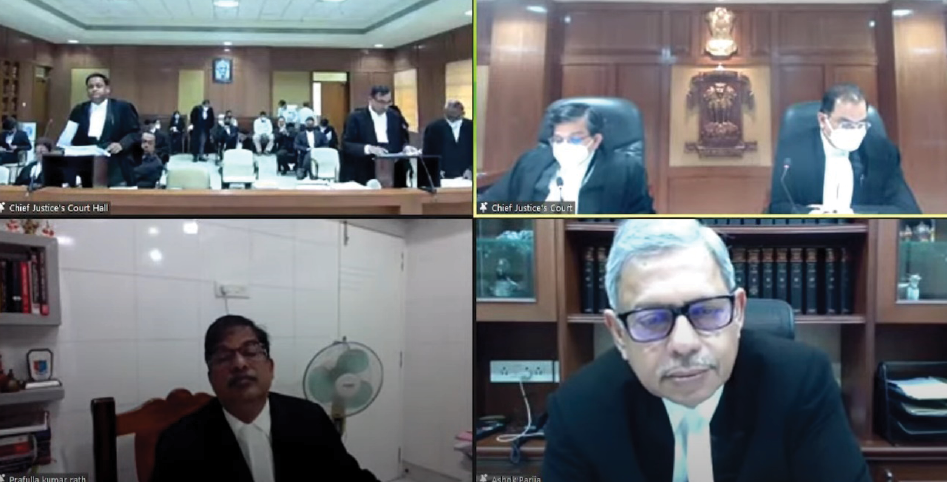
The hybrid hearing system has been accepted by advocates and litigants who have taken to it at all levels of the Courts. To help overcome any disadvantage faced by lawyers and litigants on account of the digital divide caused by the lack of access to the ICT devices and therefore to participate in the virtual hearings, the High Court provided video conferencing cabins in its premises. Likewise, in each of the district court VC cabins were provided.
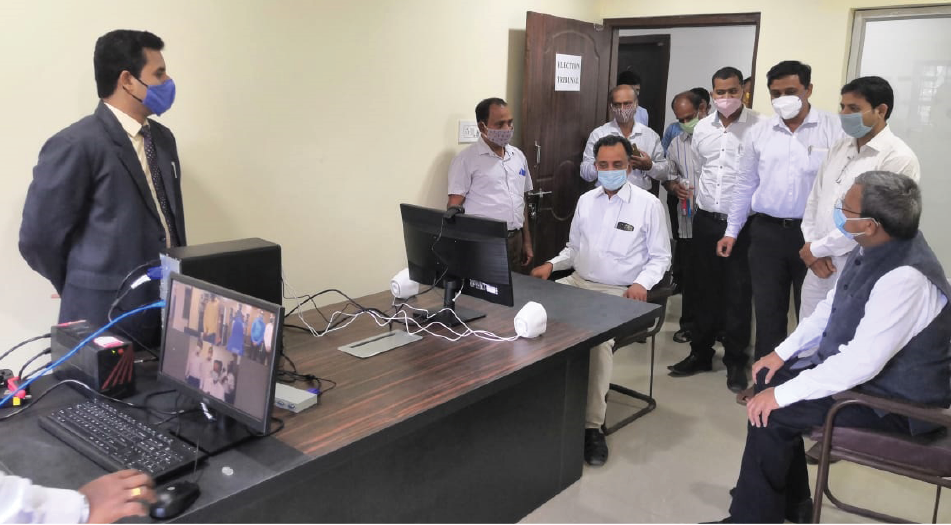
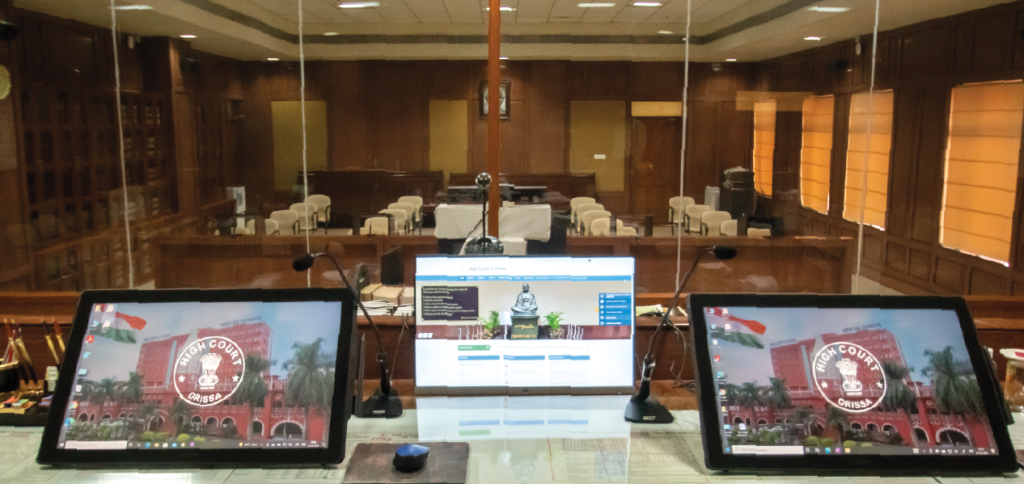
The High Court of Orissa mobilized its resources to commence transition of its Courts and offices to a paperless working environment. On 11th September 2021, the first paperless court in the High Court of Orissa in the court of the Chief Justice was inaugurated by Dr. Justice D. Y. Chandrachud, Judge, Supreme Court of India and the Chairman of the Supreme Court’s e-Committee. The court of Justice S. K. Panigrahi also went paperless from that date. Within three months, the courts of Justice B. P. Routray and Justice Savitri Ratho also went paperless.
The Judges presiding in paperless Courtrooms read scanned and bookmarked copies of case records on a customized device called ‘WACOM’, navigating through voluminous case records with the click of a mouse button.
The technological backbone to the paperless Courts initiative is provided by IDCOL Software Limited which is an IT agency of the Government of Odisha and OCAC. To augment the paperless Courts initiative, the High Court is on the anvil of automating its offices, wherein its staff shall get to work in digital environment without dealing with paper-based files. The High Court’s IT and AI Committee is supervising this initiative.
Filing of pleadings in the High Court in A4 size paper, instead of Legal Size (FS), with larger side margins, was made mandatory from 2nd February, 2021. Printing on both sides was permitted from 1st November, 2021 onwards. This should help considerably in reducing the use of paper. Printing of Orders and Judgements with the watermark of the High Court’s logo commenced on 1st July, 2021.
Traditionally, orders passed by the High Court which require compliance by Courts subordinate thereto are officially sent by Court’s staff to the concerned Subordinate Court through post. Substantial time gets consumed by the time such orders reach the subordinate Court through post resulting in possible delay in compliance. In order to address this situation, a customized Software Module called the Order Communication Portal (OCP) was launched in the month of April, 2021 to facilitate secure and instantaneous communication of orders and judgments to Subordinate Courts in a paperless environment thereby saving resources consumed in traditional methods of correspondence. Necessary policy regime was created to accord recognition to e-copy of its orders communicated through OCP.
OCP provides secure access (by certification) to nominated staff of the High Court and Subordinate Courts to send or receive orders through OCP over a secure Wide Area Network connecting the High Court and the Subordinate Courts throughout the State. The OCP has the facility to report whether or not a particular order sent through it has been accessed by the targeted Court.
More than 40, 000 orders have been communicated from the High Court to various District and Subordinate Courts across the State through OCP during the year 2021 since its launch in April, 2021.
In order to take a step closer to accomplishing paperless office and ensuring speed and accuracy in matters of official communication, initiative has been taken to foster among Judicial Officers and judicial staff, the practice of resorting to e-mail correspondence in official matters. District Judges have been requested to use official e-mails for official communication.
There has been a considerable increase in e-mail access and usage in matters of official correspondence between the High Court of Orissa and the Courts subordinate thereto since April 2021, leading to reduction in paper-based communication, better management of resources, reduction in multiplicity of processes, faster access to correspondence at any time and any place, and easy maintenance of records related to such correspondence. A large number of District and Subordinate Courts across the State of Odisha have been assigned with dedicated e-mail IDs.
In order to discontinue circulation of hard copies of Court’s notices amongst its staff which consumes substantial paper and human resources, a software module called e-NOTIFICATION SYSTEM (e-NS) has been prepared. e-NS fosters the settings for seamless and paperless circulation of all of Court’s notices amongst hundreds of its employees in a matter of seconds over a secured network accessible through computers, laptops and smartphones

Any assigned official can generate an electronic notice by uploading the final notice in PDF on e-NS and then send them to targeted recipients. e-NS provides facility to every sender of e-notice to know as to which of such recipients have actually accessed the e-notice sent by him. Hardware, training and ancillary preparations for enabling smooth transition to paperless circulation of notices through e-NS are complete.
As efforts are underway to gradually move towards a paperless and digital working regime, scanning of official records have assumed utmost importance. The High Court has provided every District Court complex with high-speed ADF scanners for meeting all official scanning-related requirements.
All District Courts have been intimated to send scanned copies of LCRs or e-LCRS whenever the High Court calls for such LCRs. These e-LCRs are to be provided after proper bookmarking which helps the Court in easy navigation through the e-case record.
The Orissa High Court Video Conferencing for Courts Rules, 2020 (‘the VC rules’) was notified to enable smooth conduct of all types of judicial proceedings through video conferencing. The VC Rules were brought into force wth effect from 5th April 2021.
(See Appendix G for High Court of Orissa’s Video Conferencing for Courts Rules, 2020)
Some of the key features of the VC rules include:
- Inclusion of all types of proceedings for video conferencing,
- Designation of Remote Points with ICT equipments from where witnesses shall depose through video conferencing,
- Nomination of Coordinators,
- Deposition of witnesses through Video Conferencing,
- Digital Signatures and Alternative Methods of Authenticating Testimony Recorded through Video Conferencing,
- Marking of Exhibits through Video Conferencing.
These rules enabled Courts to nominate coordinators for carrying out all works for the purpose of smoothly conducting Court proceedings through video conferencing and further enabled testifying by witnesses from remote points through video conferencing, recording of such testimony, transmission of the transcript to remote point for authentication thereof by the witness and the Coordinator at the remote point. Since its coming into force, the provision of VC rules have been invoked by several District and Subordinate Courts to expedite trials with far off witnesses otherwise indisposed to come to the Court physically, completing their testimony through video conferencing.
Since the coming into force of these rules, several Courts have been able to expedite adjudication of pending cases by examining witnesses through video conferencing who were finding it difficult to physically come to such Courts for deposing their evidence.
On 1st November 2021, Dr. Justice D.Y. Chandrachud, Judge, Supreme Court of India inaugurated two Model Virtual Courtrooms in the District Court complexes of Angul and Nayagarh.
Advanced Audio Video equipments and technology have been deployed in these Model Virtual Court Rooms to facilitate any participant in a Court proceeding be it the Judge, the advocate, the witness, the accused or the litigant whether in a Criminal or Civil case to attend the Court in virtual mode.
These Virtual Court Rooms have the facility of sharing live images of depositions or objects from the Court Room through a Document Visualizer.
By the end of 2021, two more virtual Courtrooms – one in the District Court complex at Bhadrak and another in the District Court complex at Malkangiri were established.
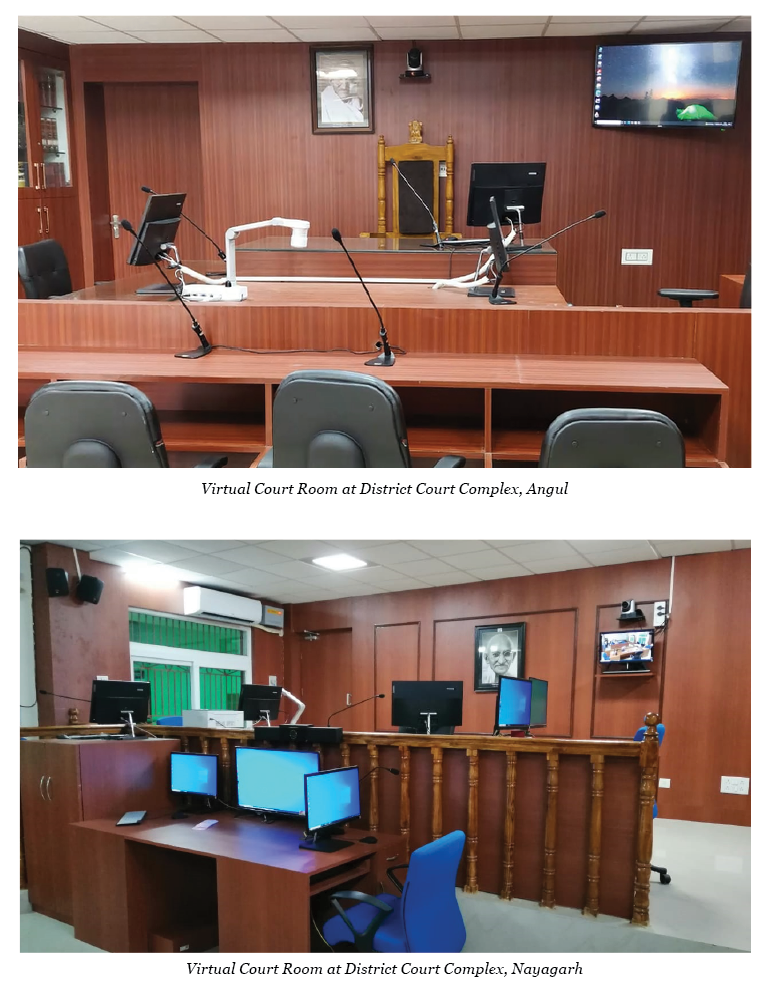
The e-Filing web portal designed by the NIC under the aegis of the e-Committee, Supreme Court of India, specifically designed to meet the requirements of advocates and litigants who file cases before the High Courts and Subordinate Courts across the country, was launched across the country for 244 court establishments across all districts of the state on 5th April 2021.
A host of steps have been taken to popularize e-filing among advocates in the High Court of Orissa. These include organizing successive hands-on training workshops for advocates on the usage of e-filing and e-payment facility, opening of e-filing help desks, mandating e-filing by the State Government and the Central Government, gradual shift from e-mail based filing to portal based e-filing, setting up of dedicated processing counters for timely follow-up on e-filed cases and so on.
The facility of e-payment of Court fees through the e-Committee’s e-pay portal for advocates and litigants in the High Court of Orissa and all District Courts of the State was launched on 5th April 2021. A Facilitation Centre for e-payment of Court fees was also inaugurated in the High Court of Orissa to help advocates and litigants in e-pay related matters.
The e-pay web portal is designed and developed by the e-Committee, Supreme Court of India through the NIC.
110 e-Sewa Kendras have been established in various Court complexes across the State which include one in the High Court of Orissa and 107 in the District and Taluka Court complexes to provide e-services to Advocates who may not have access to ICT tools to avail such services.
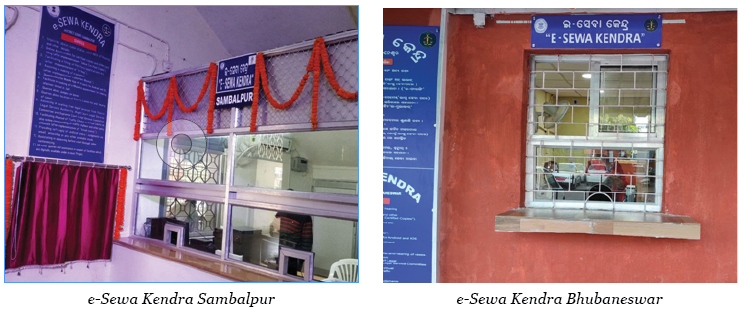
The Hands-on training module for Advocates starting with Advocates of the High Court Bar Association was inaugurated in August, 2021. This was to familiarize Advocates with the nuances of technology in their day-to-day work. Similar programmes were held for Advocates in the District Courts e-Filing Stations in District Courts/e-Facilitation Centre of the High Court.
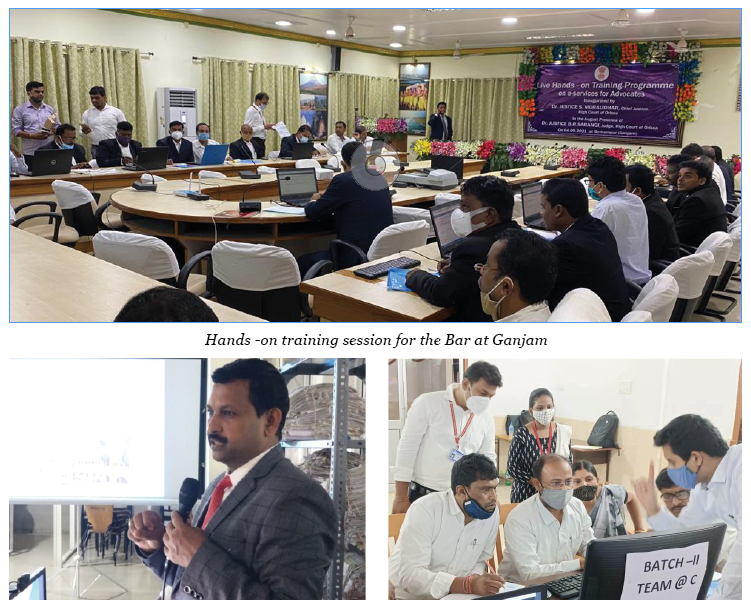
In 2021, more than 500 Advocates have been imparted hands-on training on e-filing and other essential e-services to make them familiar with computers and its usage for availing the aforementioned e-services.
The e-Facilitation Centre at High Court consists of two scanning stations and two self e-filing stations for providing all kinds of services to Advocates.
e-Filing Stations have been inaugurated in District Court complexes of Nuapada, Puri, Bhubaneswar, Rayagada, Koraput at Jeypore, Jajpur, Nabrangpur, Keonjhar.

The concept of e-Custody Certificate came into existence to help concerned Benches in ascertaining the antecedents of prisoners which in turn assist the Court in early adjudication of applications filed by such prisoners. E-Custody certificate system was launched by High Court of Orissa with effect from 1st November 2021 in close coordination with the Home Department, the Prisons Department, the office of the Advocate General and the NIC. Eventually, E-Custody Certificate System provides comprehensive information of a prisoner such as the identity of a criminal, address, the cases for which he has undergone incarceration, his antecedent and period of sentence undergone.
Request for generation of e-Custody certificate can be submitted by any authorized official of the Advocate General’s office if so required in connection with any case pending before any Bench of the High Court of Orissa.
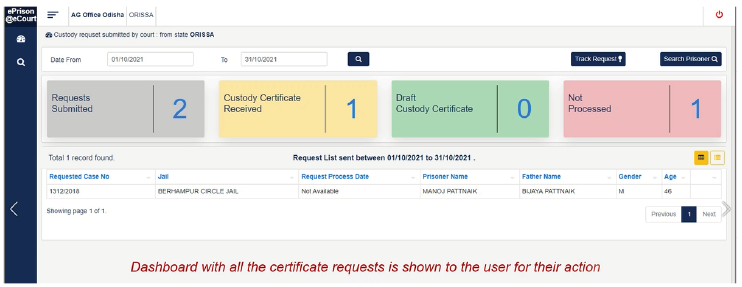
Virtual Courts for online adjudication of traffic challan cases was launched by High Court of Orissa on 2nd August, 2021. With the launch of Virtual Courts in the Cuttack-Bhubaneswar Commissionerate area on a pilot basis, lawyers and litigants in the State of Odisha will be able to conveniently settle online traffic e-challan cases arising within the area.
While the decision to design Orissa High Court’s Mobile App was taken in the year 2020, coming up with a version of the app that was optimally serviceable to stakeholders became possible in the year 2021. With the launch of this app, the ability to access Court related information has become faster and even more convenient for stakeholders particularly for learned Advocates.
The app provides specific facilities for Advocates besides a variety of features that are available in common to advocates and other users. Advocates shall also be able to use the app to see listing details of cases in which they are appearing before a specific Bench as well as in all benches at a glance.
Additionally, Advocates and general users of the app can avail of a plethora of other menu options all of which will help them navigate through multifarious categories of information relating to cases and the Court.
With the launch of this e-service with effect from 1st November 2021, orders passed by the High Court of Orissa are automatically e-mailed to designated official e-mail IDs of various Departments of the State Government whose e-mail IDs are provided with regard to a case concerning such departments. This facility aims to help departments keep up-to-date information of orders passed in cases concerning them and take expeditious steps to comply with such orders. Since its launch on 1st November 2021, total of 7, 279 orders have been sent to State Government’s departments through automated e-mails fired from the High Court’s case information servers.

Live streaming of proceedings in the Chief Justice’s Court commenced on 2nd August 2021. It can be viewed on the High Court’s official YouTube channel. The ‘High Court of Orissa Live Streaming of Court Proceedings Rules, 2021’ was simultaneously brought into force.
See Appendix H for ‘High Court of Orissa Live Streaming of Court Proceedings Rules, 2021.’
For wider and faster dissemination of Court related information, official Telegram channel and YouTube channel of the High Court of Orissa were created. Through this Channel, it is aimed to provide Advocates, litigants and members of public at large with real-time, instantaneous access to information regarding the Hon’ble Court’s events, circulars, notices, press releases, cause-lists etc.
Apart from using video conferencing for conducting judicial proceedings, several aspects of High Court’s and Subordinate Courts’ administrative functioning take place via video conferencing today according greater speed and convenience in performance of such functions.
A major example of the success of adoption of video conferencing is that in the year 2021 alone, High Court of Orissa managed to inaugurate more than 50 Courts/ Court complexes through video conferencing with some of those Courts and Court complexes located at remotest places of the State.
A Justice Clock was established in the Orissa High Court in December, 2019 to showcase various litigation-related information of the District Judiciary for lawyers and litigants who visited the High Court. But with the onset of COVID-19 restricting such visit, the information of Justice Clock had to be taken to the stakeholders instead of requiring them to be present physically to view the information. This led to conceptualization of the web version of the Justice Clock which was launched on 10th February, 2021. The web version of the Justice Clock is the digital replica of the physical Justice Clock (installed in the High Court building) linked to the High Court’s official website available for general viewing from the convenience of homes and offices.
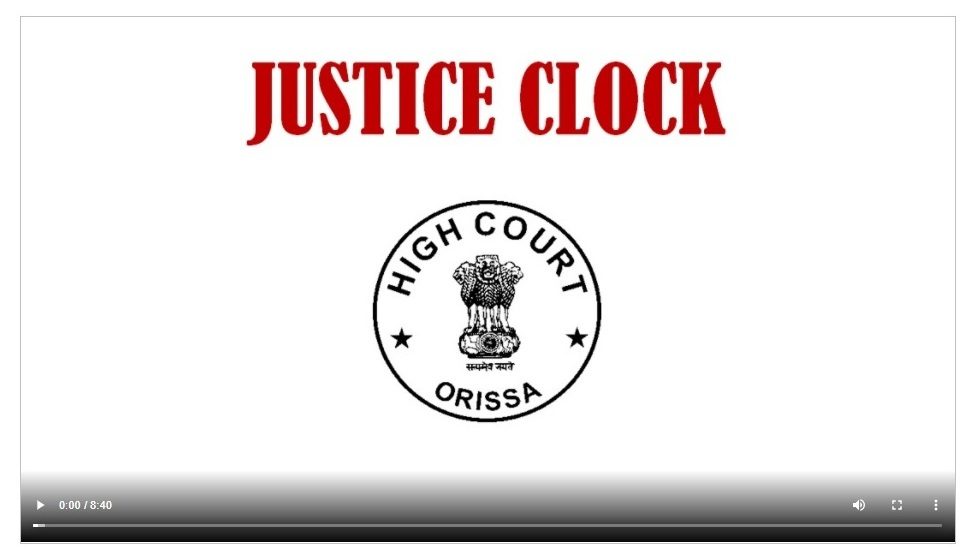
The new revamped website of the High Court was equipped with enhanced accessibility for visually challenged users. New features such as ‘e-Services’, ‘Event Calendar’ were also added in the website.
